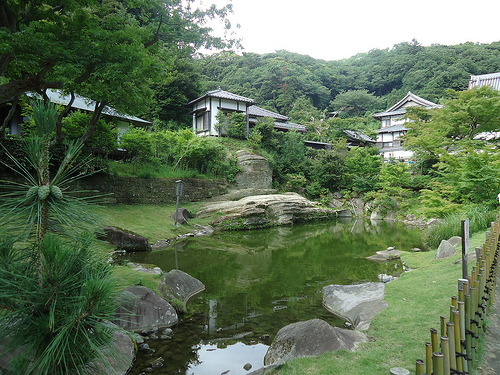Difference between revisions of "Muso Soseki"
| (3 intermediate revisions by the same user not shown) | |||
| Line 1: | Line 1: | ||
| + | [[File:Engakuji-garden.jpg|right|thumb|500px|One of the gardens at [[Engaku-ji]], designed by Musô Soseki, and designated a Place of Scenic Beauty (''meishô'')]] | ||
*''Born: [[1275]]'' | *''Born: [[1275]]'' | ||
*''Died: [[1351]]'' | *''Died: [[1351]]'' | ||
*''Japanese'': 夢窓疎石 ''(Musou Soseki)'' | *''Japanese'': 夢窓疎石 ''(Musou Soseki)'' | ||
| − | Musô Soseki was a [[Zen]] priest known for having founded a number of temples in [[Kamakura]]. | + | Musô Soseki was a [[Zen]] priest known for having founded a number of temples in [[Kamakura]], and as a designer of temple gardens. He was named ''kokushi'' ("national teacher") by seven emperors, and has been described as "probably the most famous monk of his time."<ref>de Bary, 310.</ref> |
| − | + | When he was first offered the position of abbot of a Zen monastery in Kamakura by the [[Hojo clan (Hojo Regents)|Hôjô clan]], he initially refused, instead accepting an offer from [[Emperor Go-Daigo]] to become the abbot of a temple in Kyoto, in [[1325]]. He resigned the following year, however, traveling to Kamakura and taking up a position as an abbot at that time. As head of [[Jochiji|Jôchiji]], he founded Zuisen-in, now known as [[Zuisen-ji (Kamakura)|Zuisen-ji]]. After becoming the head of [[Engakuji]], in conjunction with the [[1333]] [[fall of Kamakura]], he returned to Kyoto, founding [[Saiho-ji|Saihô-ji]], [[Shokoku-ji|Shôkoku-ji]]<ref>Mason, Penelope. ''History of Japanese Art''. Second Edition. Upper Saddle River NJ: Pearson Prentice Hall, 2005. p224.</ref>, and other temples in the [[Kyoto]] area, designing the gardens at Zuisenji and Saihôji as well. | |
| − | + | Following Go-Daigo's fall and the establishment of the [[Ashikaga shogunate]] in [[1336]], Soseki then gained the patronage of [[Ashikaga Takauji]], who in [[1339]] had him establish [[Tenryu-ji|Tenryû-ji]] in Go-Daigo's memory. | |
==References== | ==References== | ||
*"Musô Soseki." [http://www.kamakura-burabura.com/jinbutum2.htm#musousoseki Kamakura-Burabura.com]. Accessed 16 December 2009. | *"Musô Soseki." [http://www.kamakura-burabura.com/jinbutum2.htm#musousoseki Kamakura-Burabura.com]. Accessed 16 December 2009. | ||
| + | *William de Bary, ''Sources of Japanese Tradition'', vol 1, Columbia University Press (2001), 310. | ||
<references/> | <references/> | ||
[[Category:Kamakura Period]] | [[Category:Kamakura Period]] | ||
[[Category:Religious Figures]] | [[Category:Religious Figures]] | ||
Latest revision as of 15:02, 9 February 2015

Musô Soseki was a Zen priest known for having founded a number of temples in Kamakura, and as a designer of temple gardens. He was named kokushi ("national teacher") by seven emperors, and has been described as "probably the most famous monk of his time."[1]
When he was first offered the position of abbot of a Zen monastery in Kamakura by the Hôjô clan, he initially refused, instead accepting an offer from Emperor Go-Daigo to become the abbot of a temple in Kyoto, in 1325. He resigned the following year, however, traveling to Kamakura and taking up a position as an abbot at that time. As head of Jôchiji, he founded Zuisen-in, now known as Zuisen-ji. After becoming the head of Engakuji, in conjunction with the 1333 fall of Kamakura, he returned to Kyoto, founding Saihô-ji, Shôkoku-ji[2], and other temples in the Kyoto area, designing the gardens at Zuisenji and Saihôji as well.
Following Go-Daigo's fall and the establishment of the Ashikaga shogunate in 1336, Soseki then gained the patronage of Ashikaga Takauji, who in 1339 had him establish Tenryû-ji in Go-Daigo's memory.
References
- "Musô Soseki." Kamakura-Burabura.com. Accessed 16 December 2009.
- William de Bary, Sources of Japanese Tradition, vol 1, Columbia University Press (2001), 310.